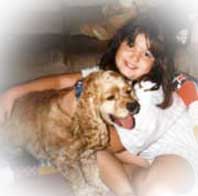Checkmate's CockerCondo:
a rescued cocker spaniel




Children and Dogs:
Creating Harmony in Your Home
A lot of Rescue people will tell you that cocker spaniels and children don't mix.
I think that is a prejudicial statement. It depends on the child. It depends on the dog. But it's an issue that needs to be addressed.
On this page I'm presenting different perspectives:
- My opinion after living with cockers and a child
- An article from a nationally circulated magazine
- The comments of a Rescue organization
- An online article by a veterinanrian
We've also added a link for familes with dogs bringing home a new baby
![]()
When a dog moves into a new family, he has to figure out the "pecking order", or "who is really in charge here, and where do I fit in?"
In our home, there is a very alpha dog, "Mom", "Dad" and child. "Mom" is domestic goddess, purveyor of food, walks and cuddles, she's "sacred". "Dad" and Buddy both think that they are in charge [Mom's itals], so that left Checkmate and [the girl] at the bottom of the ladder. Checkmate felt he had to had to assert himself as the beta dog at the child's expense. Checkmate really frustrated all of us by chasing the child through the house for the stupidest reasons. But hey, if she runs or backs down , then he's the beta dog and she's the charlie, right?
The "experts" say that the way to handle this is that the child should not run away or express fear, it encourages the negative behavior. The dog needs a little more attention, especially petting, to distract him. He needs to be made to think that maybe he is the beta (or alpha) dog AT THAT MOMENT. Come to think of it, [the girl] and Checkmate got into the most scrapes when everyone first came home form work/school and Checkmate had been at home, BORED, all day long!
![]()
I found the following article in the December/January 1999 issue of Working Mother magazine. We'd like to share:
Avoiding Dog Bites
A third of all dog bites happen to youngsters ages five to nine, and the injuries can be serious. Unlike adults, children are more likely to be bitten on the face, as well as the arms, hands and legs.
"More children get bitten each year than get measles, mumps and whooping cough combined," says J. Michael Cornwell, DVM, of Ohio State University's College of Veterinary Medicine, department veterinary preventative medicine, who has developed simple guidelines for avoiding these injuries.Among his suggestions:
Be a tree. If approached by a unfamiliar or growling dog, children (or adults) should stand still with their feet together and fists folded under their neck with arms and elbows against their chest.
Never run. "Dogs instinctively chase moving objects," says Cornwell, who notes that unfortunately it's instinctive for children un or scream in fear. Explain to them that if they nd still long enough, the dog will just get bored and leave.
Act like a log. If a child is lying down or has been knocked down, the best response is to lie facedown with fists folded behind the neck and forearms covering the ears.
![]()
To be fair, I'll present the answer to this question as fielded by Oldies But Goodies Cocker Spaniel Rescue of Northern Virginia on one of their hand-outs:
Question: Are cocker spaniels good with children?
Answer: It depends. Twenty years ago, or more, cocker spaniels were highly regarded as being sweet tempered and gentle with children, no matter how much the children might rough house with the dog. With the advent of the Disney movie, "Lady and the Tramp" however, back yard breeders stepped in to take advantage of the increased demand for cockers, and continual in-breeding caused many lesser quality traits to come to the fore. Today, cockers are still wonderful dogs and can be wonderful, loving pets, but only if you understand that these dogs do have some limitations. These rescued dogs have also been uprooted from their previous homes, either from neglect or abuse, and thrust into a totally new world with no fixed roots as yet. To expect anyone, let alone a poor defenseless animal, to remain sweet and loving in a new, more stressful environment with very young children, is a very high expectation indeed. Yet, for the most part, these dogs are even tempered and will give lots of love and attention to any owner willing to recognize what they have undergone, and who is willing to devote a good deal of time, love, patience, and attention to their dog's well-being.
Given the fact that children will naturally want to play with their new pet, one has to recognize the problems and possible abuse that the cocker has already undergone. Thus, it is important to ask the Cocker Rescue people whether this or that cocker would be good with children. Some cockers we would not recommend to anyone with children, at any age, simply because the dog might have been severely abused by a child and distrusts or fears all children. Some dogs might be fine for "older children", who are more mature and understanding of the background of their new pet and do not consider the dog a toy. Then, there are those cockers who have a sweet, gentle disposition and who would probably work out wonderfully for any family with children.
In short, it depends! It is so important to talk to the Cocker Rescue people to check whether the cocker you are considering would be good with children. Please tell us the ages, and temperament of your children. We can then advise you whether the dog you have selected could tolerate the stress and demands that children bring to the play arena. None of us want a dog to bite due to being put on the defensive in what children consider "play". It is our current policy not to adopt any rescued cockers to families who have any children under 8 years of age. This policy is somewhat flexible, but we believe we have to examine conditions very carefully, given the changes in cockers over the years, and for the happiness of both your children and the rescued cocker.
![]()
The following exerpt was posted on a website for DVM News magazine:
"...What was even more appalling to me, was when the strange kids ran up to hug [a] dog. This is never a behavior that should be encourage by clients. In fact, veterinarians can do a very good service by discouraging this type of behavior.
- Unfamiliar dogs should only be approached after asking permission of the handler, after the handler has asked the dog to sit.
- Children can then be invited to gently pet the dog after confidently offering the dog a still, closed hand to sniff.
To do otherwise is to raise children to be bitten sooner, rather than later or never. The sad truth is that most children in the U.S. have been bitten by a dog by the time they are 12 years old. Dog bites to children, most of which go unreported to public health agencies, are an epidemic. Children under the age of 4 are grossly over-represented in this country as those who die because of a dog attacks. There are dogs who pose a danger to children. These dogs should not live in homes with children ... [This] continues to contribute to the mythology about dogs and dog bites.
This page last updated 3/31/02 Get
your own FREE Website at
Get
your own FREE Website at 





